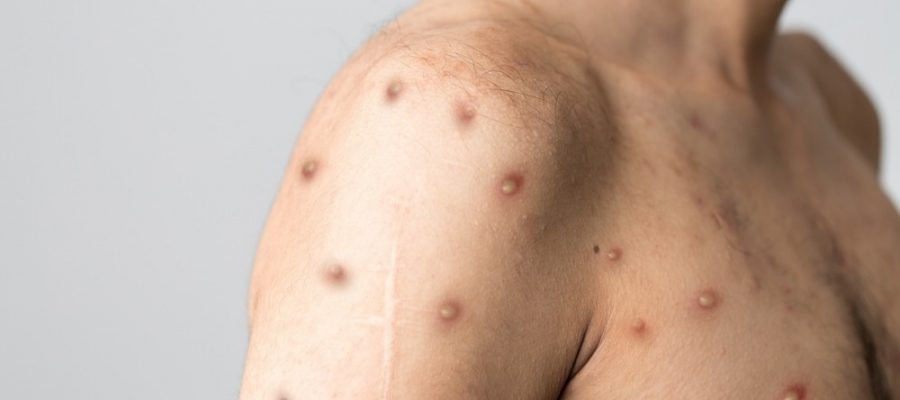In a recent study published in Clinical Microbiology and Infection, researchers described the clinical characteristics and complications of monkeypox (MPX) virus (MPXV) infections.

Background
The current global 2022 outbreak has occurred via human-to-human MPXV transmission among non-endemic nations, whereas earlier outbreaks occurred in endemic nations via zoonotic MPXV transmission. The clinical profiles of MPXV-positive patients in the 2022 MPXV outbreak have not been well-characterized.
About the study
In the present observational cohort study, researchers described the demographical and clinical characteristics of MPX among 264 polymerase chain reaction (PCR)-confirmed MPX patients who visited a referral center in France.
The study comprised consecutively diagnosed MPX patients between 21 May and 5 July 2022 at the hospital of the Bichat Claude Bernard university in Paris. Of the participants, ≥1 and ≤3 samples were obtained viz. oropharyngeal swabs, skin swabs, and blood samples, and subjected to real-time PCR assays.
The assays were validated by the CDC (centers for disease control & prevention) and the national center for Orthopoxviruses in France i.e., IRBA (Institut de Recherche Biologique des Armées). Routinely obtained data were extracted anonymously from the patients’ electronic medical records. Continuous variables were described as interquartile ranges (IQRs) and medians, whereas categorical variables were described as percentages and numbers.
Results
Among the participants, 99% (n=262) were males, and 95% (n=245) were MSM (males who have sex with males) patients, 42% (n=90) practiced chemsex in the previous three months, and 29% (n=73) suffered from human immunodeficiency virus (HIV). Over 70% (n=120) were on HIV pre-exposure prophylaxis (PrEP). Over 46% (n=112) of participants had contact with MPX cases, of which most (95%, n=86) were sexual encounters.
The median count of sexually active partners in the previous month was five [IQR two to 10] and a history of STI (sexually transmitted infection) was reported by 89% (n=209) of patients, 74% (n=139) of which occurred in the previous year. The median duration between contacting an MPX-positive patient and symptom onset was six days (IQR three to eight days), consistent with the MPXV incubation period.
The median age of patients was 35 years, 33% (n=76) had a travel history to non-Central African regions in the previous month, and 18% (n=38) had pets such as dogs or cats. Over 11% (n=29) patients had received smallpox vaccinations, and four of them had received post-exposure ring vaccinations with (IMVANEX(c)) third-generation smallpox vaccine during the current 2022 outbreak.
Skin samples, oropharyngeal samples, and blood samples from 252 participants, 150 participants, and eight participants were MPXV-positive, respectively. Among 53% (n=136) of participants, there were no prodromal symptoms prior to the development of dermatological lesions. The median value for the duration between symptom onset and the appearance of dermatological lesions was three days (IQR two to four) days.
Most of the participants developed fever (68%, n=171) and adenopathy (69%, n=174). Skin lesions were most frequently observed in the genital (54%, n=135) and perianal (40%, n=100) regions. Typical lesions observed were papules (34%), vesicles (57%), pustules (33%), ulcers (34%), scabs (24%) and rashes (8%). Notably, 17% (n=45) of patients reported several flare-ups, and the median duration between the falling of scabs and skin lesion onset was 17 days (IQR 12 to 18).
Of the participants, six percent (n=17) were admitted to hospitals, all males, although none suffered from immunosuppressive conditions. MPX complications were observed in 36% (n=92) patients, and the most commonly observed ones were pain in the anal region (18%) and cellulitis (10%). However, complications that required hospital admissions were cellulitis, paronychia, severe digestive and anal involvement, non-cardiac angina and dysphagia, blepharitis, and keratitis observed in four, three, four, four, one, and one patient, respectively.
All except one MPX patient were suspected to have bacterial superinfections and therefore received antibiotic medications with painkillers such as opioid drugs (seven patients) and acetaminophen (17 patients), and opioids (7/17). Patients with ocular involvement (n=2) were administered oral antivirals (tobramycin, valaciclovir, and ganciclovir) with dexamethasone and intravenous antiviral injections of cidofovir in five mg per kg concentrations.
Surgical drainage was required for four participants (two cases and one case of paronychia and cellulitis, respectively), and Staphylococcus aureus was detected in all their samples. The median duration of hospital admission was three days, and MPX management was multidisciplinary in 76% (n=13) of cases. MPX symptoms fully resolved in all patients except one with keratitis.
Conclusion
Overall, the study findings highlighted the characteristics of MPX viz. (i) MPX occurs among MSM individuals, (ii) through sexual contact, (iii) most frequently affects anal and perineal regions, and (iv) severe complications include paronychia, superinfected dermatological lesions, digestive and anal involvement, cellulitis, ocular lesions, angina, and dysphagia. Further research, including multicentric trials and longer follow-up periods, is required to identify the risk factors for severe MPX complications and develop management approaches, including specialists from different disciplines of medicine.
- Mailhe, M. et al. (2022) "Clinical characteristics of ambulatory and hospitalised patients with monkeypox virus infection: an observational cohort study", Clinical Microbiology and Infection. doi: 10.1016/j.cmi.2022.08.012.
Posted in: Medical Science News | Medical Research News | Disease/Infection News
Tags: Acetaminophen, Angina, Antibiotic, Blepharitis, Blood, Cellulitis, Dexamethasone, Drugs, Dysphagia, Electronic Medical Records, Fever, HIV, Hospital, Immunodeficiency, Keratitis, Medicine, Microbiology, Monkeypox, Opioids, Pain, Paronychia, Polymerase, Polymerase Chain Reaction, Pre-Exposure Prophylaxis, Prophylaxis, Research, Skin, Smallpox, Staphylococcus aureus, Vaccine, Virus

Written by
Pooja Toshniwal Paharia
Dr. based clinical-radiological diagnosis and management of oral lesions and conditions and associated maxillofacial disorders.
Source: Read Full Article
